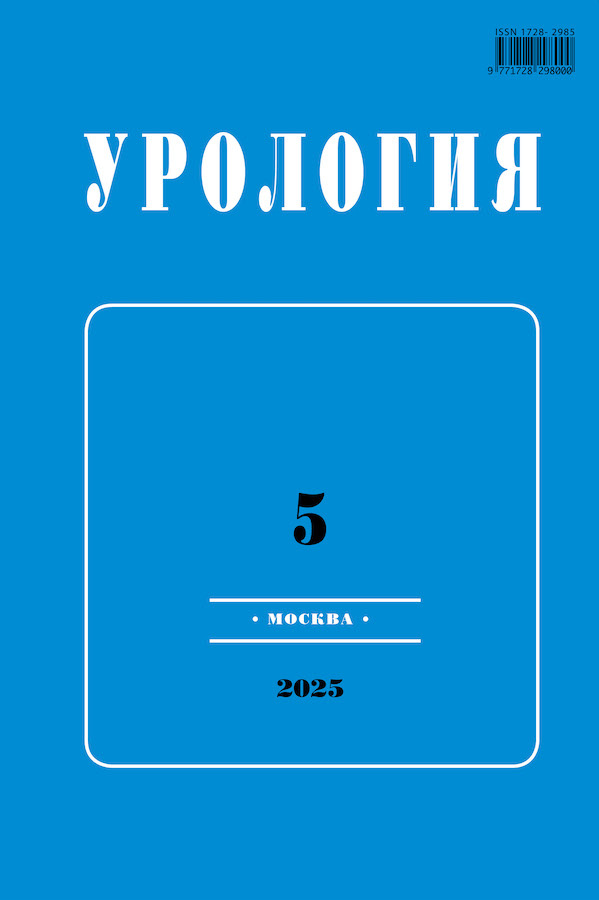Use of high-dose vitamin C and Suby G solution in the treatment of encrusted cystitis
- Authors: Kosova I.V.1,2, Barsegian V.A.3, Loran O.B.1, Saenko V.S.4, Kolbasov D.N.2, Grigoriev N.A.3
-
Affiliations:
- Russian Medical Academy of Continuous Professional Education
- Demikhov City Clinical Hospital (branch №2)
- European Medical Center
- Sechenov University
- Issue: No 5 (2025)
- Pages: 126-129
- Section: Clinical case
- Published: 18.11.2025
- URL: https://journals.eco-vector.com/1728-2985/article/view/696538
- DOI: https://doi.org/10.18565/urology.2025.5.126-129
- ID: 696538
Cite item
Abstract
This article describes a clinical case of the successful use of high doses of vitamin C and Suby G solution to reduce urine acidity in a patient with encrusted cystitis. The previously used combination of oral methionine intake and intravesical instillations of a 3% aqueous boric acid solution was ineffective. As part of comprehensive therapy, transurethral resections of bladder wall encrustations were performed, along with antibacterial therapy with vancomycin. The obtained results indicate the potential effectiveness of this combination; however, further clinical studies are needed to verify them.
Keywords
Full Text
About the authors
Inga V. Kosova
Russian Medical Academy of Continuous Professional Education; Demikhov City Clinical Hospital (branch №2)
Email: kosovainga@mail.ru
ORCID iD: 0000-0002-0051-0583
M.D., Dr. Med. Sc., Assoc. Prof., Professor at the Department of Urology and Surgical Andrology, Urologist at the Department of Urology (branch №2)
Russian Federation, Moscow; MoscowVagan A. Barsegian
European Medical Center
Author for correspondence.
Email: vaganbarsegyan@gmail.com
ORCID iD: 0000-0003-0592-3181
M.D., Ph.D., Urologist, Urology Clinic
Russian Federation, MoscowOleg B. Loran
Russian Medical Academy of Continuous Professional Education
Email: oleg_loran@gmail.com
ORCID iD: 0000-0002-7531-1511
Academician of the RAS, Dr. Med. Sc, Professor, Chief of the Department of Urology and Surgical Andrology
Russian Federation, MoscowVladimir S. Saenko
Sechenov University
Email: saenko_vs@staff.sechenov.ru
ORCID iD: 0000-0003-3107-8161
M.D., Dr. Med. Sc., Assoc. Prof., Professor at the Institute of Urology and Human Reproductive Health
Russian Federation, MoscowDmitriy N. Kolbasov
Demikhov City Clinical Hospital (branch №2)
Email: urology68@rambler.ru
M.D., Ph.D., Chief of the Department of Urology №2
Russian Federation, MoscowNikolay A. Grigoriev
European Medical Center
Email: ngrigoriev@emcmos.ru
M.D., Dr. Med. Sc., Professor, Chief of the Urology Clinic, Chief of the Department of Urology, EMC Medical School
Russian Federation, MoscowReferences
- Van de Perre E, Reichman G, De Geyter D, Geers C, Wissing KM, Letavernier E. Encrusted Uropathy: A Comprehensive Overview-To the Bottom of the Crust. Front Med (Lausanne). 2021 Jan 21;7:609024. doi: 10.3389/fmed.2020.609024. PMID: 33553205; PMCID: PMC7858656.
- Fu JG, Xie KJ. Successful treatment of encrusted cystitis: A case report and review of literature. World J Clin Cases. 2020 Sep 26;8(18):4234-4244. doi: 10.12998/wjcc.v8.i18.4234. PMID: 33024784; PMCID: PMC7520765.
- Gadzhiev N.K., Malikiev I.E., Obidnyak V.M. et al. The Problem of Clinical Diagnostics and Treatment of Incrusting Cystitis. Urology. 2022;5:142–146. doi: 10.18565/urology.2022.5.142-146. EDN PJJTYW. Russian (Гаджиев Н.К., Маликиев И.Е., Обидняк В.М. и др. Проблема клинической диагностики и лечения инкрустирующего цистита. Урология. 2022;5:142–146. doi: 10.18565/urology.2022.5.142-146. EDN PJJTYW).
- Kosova I.V., Barsegian V.A., Loran O.B. et al. Etiological factors in the development of urinary disorders in women. Consilium Medicum. 2022;24(7):451–455. doi: 10.26442/20751753.2022.7.201791. EDN CPEKHD. Russian (Косова И.В., Барсегян В.А., Лоран О.Б. и др. Этиологические факторы развития нарушений мочеиспускания у женщин. Consilium Medicum. 2022;24(7):451–455. doi: 10.26442/20751753.2022.7.201791. EDN CPEKHD).
- Barsegian V.A., Kosova I.V. Role of the lower urinary tract viral infections in the development of female micturition disorders. Urology. 2022;5:117–122. doi: 10.18565/urology.2022.5.117-122. EDN PXSTHU. Russian (Барсегян В.А., Косова И.В. Роль вирусных инфекций нижних мочевыводящих путей в развитии нарушений мочеиспускания у женщин. Урология. 2022;5:117–122. doi: 10.18565/urology.2022.5.117-122. EDN PXSTHU).
- Soriano F., Tauch A. Microbiological and clinical features of Corynebacterium urealyticum: urinary tract stones and genomics as the Rosetta Stone. Clin Microbiol Infect. 2008;14(7):632–43. doi: 10.1111/j.1469-0691.2008.02023.x. PMID: 18558935.
- Perrucci E., Lancellotta V., Benedetto M.D., Palumbo I., Matrone F., Chiodi M., Lombi R., Marcantonini M., Mariucci C., Aristei C. Encrusted cystitis after definitive radiotherapy for cervical cancer: a case report. J Contemp Brachytherapy. 2016;8(6):541–543. doi: 10.5114/jcb.2016.62958. PMID: 28115961; PMCID: PMC5241373.
- Benoit G., Eschwege P., Paradis V., Droupy S., Nordmann P., Charpentier B. Successful treatment of encrusted pyelitis in a renal transplant with local acidification and surgical ileocaliceal anastomosis. J Urol. 1999;162(4):1369–70. PMID: 10492200.
Supplementary files












